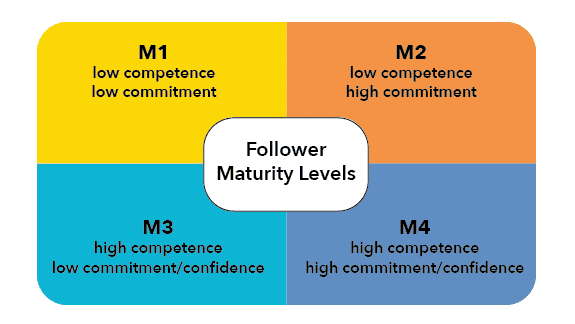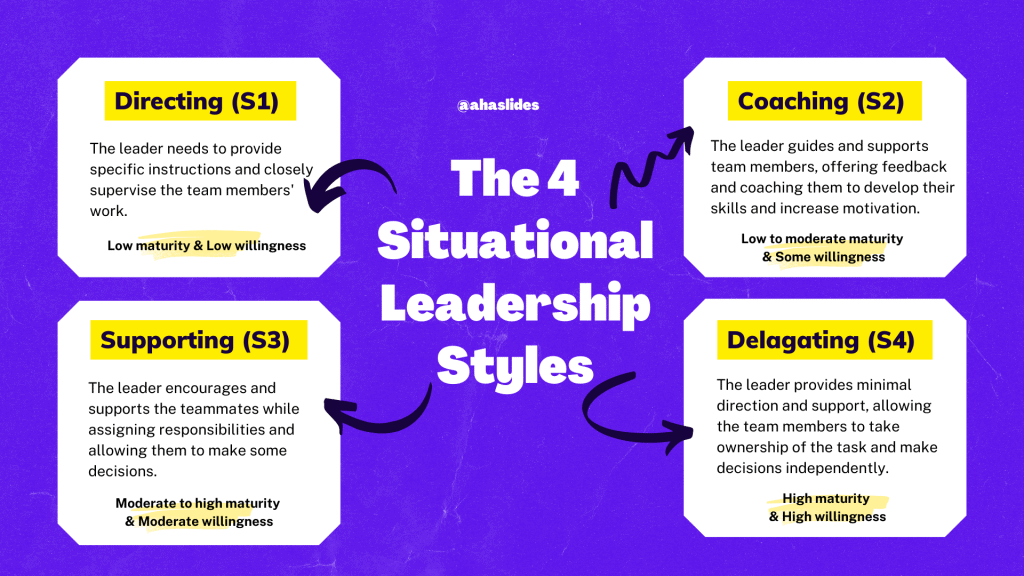您是否初入管理職位,對採用哪種領導風格感到困惑?您是否仍在苦思哪種風格最適合您的個性?別擔心,您並不孤單。許多新任經理都面臨同樣的挑戰。
好消息是,有一個解決方案不需要你強迫自己適應任何特定的風格。這個策略叫做 情境領導。因此,在本文中,我們將定義情境領導並討論它如何幫助您作為經理。
目錄
有關 AhaSlides 領導力的更多信息
| 誰發明了『情境領導』一詞? | 保羅·赫西 |
| 發表在哪本書上? | 1969 |
| 包含「情境領導」一詞的書名是什麼? | 組織行為管理:利用人力資源 |
| 誰發明了情景方法? | 赫西和布蘭查德 |
什麼是情境領導?
情境領導是一種基於情境領導理論的領導方法,它表明 沒有適用於所有情況的一刀切的領導風格,偉大的領導者必鬚根據團隊成員的成熟程度和承擔責任的意願,視情況調整他們的方法以滿足團隊成員的特定需求。

但管理者如何評估員工的成熟度和意願水平? 這是一個指南:
1/ 成熟度
四個成熟度級別定義如下:
- M1 – 能力低/承諾低: 此級別的團隊成員經驗和技能有限。 他們需要詳細的指導、指導和監督才能成功完成任務。
- M2 – 一定能力/可變承諾: 團隊成員有一些與任務或目標相關的經驗和技能,但他們可能仍然不確定或缺乏持續執行的信心。
- M3 – 高能力/可變承諾: 團隊成員擁有豐富的經驗和技能,但他們可能缺乏動力或信心來盡其所能完成任務。
- M4 – 高能力/高承諾: 團隊成員擁有豐富的經驗和技能,他們可以獨立工作,甚至可以提出改進任務或目標的建議。

2/ 意願水平
意願水平指的是 準備和動機 員工完成任務或目標。 有四種不同的意願水平:
- 低意願: 在這個級別,團隊成員不願意承擔完成任務或目標的責任。 他們也可能對自己執行任務的能力感到不確定或不安全。
- 一些意願: 團隊成員仍然無法對任務承擔全部責任,但他們願意學習和提高自己的技能。
- 中等意願: 團隊成員可以承擔任務,但缺乏獨立完成任務的信心或動機。
- 高意願: 團隊成員既有能力也願意為任務承擔全部責任。
通過了解以上兩個層次,領導者可以應用與每個階段相匹配的領導風格。 這有助於團隊成員發展他們的技能,建立他們的信心,並增加他們的積極性,最終提高績效和結果。
然而,如何有效地將領導風格與這些層級相匹配呢?讓我們在接下來的章節中一探究竟吧!
四種情境領導風格是什麼?
由 Hersey 和 Blanchard 開發的情境領導模型提出了 4 種與團隊成員的意願和成熟度水平相匹配的領導風格,如下所示:

- 指導型(S1)-成熟度低且意願低: 這種方法最適合需要領導者明確指導的新團隊成員。 為了確保他們的隊友成功完成任務,領導者必須提供具體指示。
- 輔導(S2)-成熟度低到中等,且有一定的意願: 這種方法適合那些對任務有一定專業知識但缺乏獨立完成任務信心的人。 領導者必須提供指導並指導他們的團隊成員,以幫助他們發展技能並增強他們的積極性。
- 支持(S3)-中等至高度成熟度和中等意願: 這種方法最適合具有專業知識和完成任務信心但可能需要鼓勵和支持才能發揮最佳水平的團隊成員。 領導者需要允許隊友做出決定並掌握任務的所有權。
- 授權(S4)-高成熟度和高意願: 這種風格最適合那些有豐富經驗並有信心完成任務並承擔額外責任的人。 領導者只需提供最低限度的指導和支持,團隊成員可以獨立做出決定。
透過將適當的領導風格與團隊成員的發展水平相匹配,領導者可以最大限度地發揮追隨者的潛力並取得更好的結果。
情境領導的例子
以下是情境領導力在現實世界中的應用範例:
假設你是一家軟體開發公司的經理,你的團隊由四位開發人員組成。每位開發人員的技能和經驗水平各不相同,他們共同開發一個專案。因此,你必須根據他們的開發程度調整你的領導風格。
| 隊員 | 發展水平(成熟度和意願) | 情境領導風格 |
| 開發商A | 她技術高超,經驗豐富,幾乎不需要指導 | 委派 (S4):在這種情況下,您可以將任務委派給他們,讓他們獨立工作,只是偶爾檢查一下,以確保一切都按計劃進行。 |
| 開發商乙 | 他技術嫻熟,但缺乏經驗。他需要一些指導和指引,但一旦了解了對他的期望,他就能獨立工作。 | 支持(S3): 在這種情況下,您應該提供明確的說明並經常檢查以回答任何問題並提供反饋。 |
| 開發商丙 | 她的技能和經驗都比較少。 他需要更多的指導和方向,並且可能需要一些指導來發展他們的技能。 | 輔導(S2): 在這種情況下,您將提供明確的說明,密切監控他們的進度,並提供定期反饋和指導。 |
| 開發商丁 | 他是公司的新人,對您所使用的技術經驗有限。 他們需要循序漸進的指導和指導,並且需要廣泛的培訓和支持才能跟上進度。 | 指揮(S1):在這種情況下,您將提供廣泛的培訓,並密切監控他們的進度,直到他們能夠更獨立地工作。 |
此外,你也可以參考喬治·巴頓、傑克·斯塔爾、菲爾·傑克森等情境領導者的例子,觀察並學習他們的做法。
情境領導的好處
一個成功的領導者必須能夠識別人才,培養人才,並將其放在適當的位置,幫助他的隊友發展。
定期調整你的領導風格以滿足員工的需求有時會很困難,但這無疑是有益的。 以下是情境領導的一些好處:
1/ 增加靈活性
情境領導使領導者可以更靈活地領導團隊。 領導者可以根據情況調整他們的領導風格,從而提高績效和成果。
2/ 改善溝通
與專制型領導和單向溝通相比,情境領導力強調領導者與團隊成員之間有效溝通的重要性。透過交談和分享,情境管理者能夠更了解團隊成員的優勢和劣勢,並為他們提供支持和指導。
3/ 建立信任
當情境領導者花時間提供適當程度的支持和指導時,他們可以展現對團隊成員成功的承諾,從而增加信任和尊重。
4/ 以更好的表現創造動力
當領導者採用情境領導方法時,他們更有可能讓下屬參與職業發展,以提供有用的指導和建議。 這可以提高員工的敬業度和積極性,從而帶來更好的績效和結果。
5/創造健康的工作環境
情境領導可能有助於建立一種重視開放溝通、尊重和信任的健康文化,並幫助員工輕鬆地分享他們的想法和想法。

情境領導的缺點
儘管情境領導可以是一種有益的領導模式,但情境領導有幾個缺點需要考慮:
1/ 耗時
應用情境領導需要領導者投入大量精力和時間來評估下屬的需求並相應地調整他們的領導風格。 這需要耐心,在一些快節奏的工作環境中可能無法做到。
2/ 不一致
由於情境領導力要求領導者根據具體情況調整領導風格,這可能導致領導者對待下屬的方式不一致。這可能會讓追隨者難以理解領導者的期望。
3/ 過度依賴領導者
在某些情境領導方法的情況下,團隊成員可能會過度依賴領導者提供指導和支持,導致缺乏主動性和創造力,從而限制他們的成長和發展潛力。
關鍵要點
總的來說,情境領導在有效實施時可以成為一種有價值的領導模式。 通過提供支持、促進協作、鼓勵自主和培養積極的文化,領導者可以創造一個支持員工福祉和生產力的健康環境。
然而,領導者必須仔細考慮潛在的不利因素,並採取措施減輕這些不利因素,以確保順利應用。
並記得讓 啊哈幻燈片 使用我們的模板庫幫助您成為成功的領導者。 我們的 預製模板 從培訓課程到會議和破冰遊戲,為您提供激勵員工的靈感和實用資源。
*參考: 很好的頭腦









